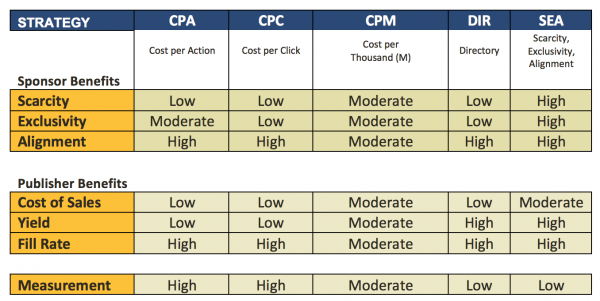
Multiplatform publishers can generate revenue from users, from sponsors, or both. Consumer-focused portals that are sponsorship-driven and engage in sponsorship advertising ask users to pay – not with money, but with time and information. They spend time viewing web pages and signing up for email feeds, thus creating advertising inventory that can be used to sell the publisher’s products (internal advertising) and/or sold to third-party sponsors (external advertising) on a CPM, CPC, CPA, or SEA basis.
[text_ad]
There are five unique ways a publisher makes money through sponsorship advertising, although they’re sometimes mixed and matched:
- CPA (cost per action) – Based on how many sales or leads an ad generates
- CPC (cost per click) – Based on how many clicks an ad receives
- CPM (cost per thousand) – Based on the number of page views an ad receives
- DIR (directory) – Based on the sale of a directory listing
- SEA (sponsorships) – Based on selling dedicated ad packages to entire sections of your website
If you think we forgot native ads, we consider these a choice that can be used in any of these different models, not a model in itself.

In the chart above, we’ve gathered the experiences of the hundreds of publishers we’ve worked with and spoken with to determine which sponsorship advertising models provide the most value for both the sponsor and the publisher. We’ve evaluated the 5 different models using the following criteria:
Sponsor Benefits
- Scarcity: Is it easy to land an ad in prime real estate (low), or is it hard (high)?
- Exclusivity: Will you be competing with a lot of other advertisers (low), or few (high)?
- Alignment: Are the ads less relevant to the content on the page (low), or very relevant (high)?
Publisher Benefits
- Cost of Sales: Does it take less money to make money (low), or more money to make money (high)?
- Yield: Does is create a small portion of revenue (low), or a significant amount (high)?
- Fill Rate: Is it hard to sell these ads (low), or are they easy to sell (high)?
And finally, are the results hard to measure (low), or easy to measure (high)?
CPA (Cost Per Action)
CPA advertising involves finding out what a retailer is willing to pay you per action, sale, or lead.
CPA advertising is easy to measure, easy to align with the content you’re publishing, and cheap to implement (free, actually), but requires a high volume of traffic to generate significant revenue.
Implementing CPA advertising is as simple as partnering with CPA partners like Amazon, or CPA networks like ClickBank or ShareaSale. When you decide to generate revenue with CPA affiliate advertising, you have control over the ad’s effectiveness. Most advertisers provide an inventory of ad options that you can choose to place wherever you want to on your website.
IMDb.com uses CPA advertising to drive users to purchase movies and other items, and is owned by Amazon because it became such a valuable affiliate. IMDb.com is supported by a variety of advertising, licensing, and sponsorship opportunities aimed at people both inside and outside of the film industry. Links to Amazon.com appear sprinkled throughout the pages of IMDb and in “related products” sidebars, for people wanting to buy related Blu-rays and books.
[text_ad]
CPC (Cost Per Click)
CPC sponsorship advertising involves accepting an ad on your site, where the advertiser pays for every click they get, regardless of whether they buy anything or perform an action, like submitting their email address.
Google isn’t the only CPC network, but it’s certainly one of, if not the largest. This is because when you use Google Adsense on your website, Google’s ad algorithm will display ads that are contextually relevant to the content on the page. This increases click-rates and user satisfaction. The publisher is paid through Adsense, which is also the platform advertisers use to set up their ads and decide how much they’re willing to pay per click on their ad.
CPM (Cost Per Thousand)
CPM advertising can be most directly compared to traditional print advertising, where the advertiser is paying for eyes on their ad. In this case, they’re paying per thousand views regardless of whether the user takes an action or clicks.
The challenge is some publishers have been selling digital ads on the cheap, and thus, many have been unhappy with their revenues compared to their print revenues. We’ve heard the term “trading print dollars for digital dimes” and then “trading digital dimes for mobile pennies.”
At Mequoda, we believe CPM rates for digital magazine advertising should be the same for digital editions as for print. But in surveying rate cards across the industry, we find many publishers simply give away digital edition ads to print advertisers.
Others make no mention of their digital magazine at all, leaving us to assume they also give away those ads to print advertisers or don’t advertise once a user is logged in. In the past, Popular Science has been one of the few exceptions, and they find advertisers are willing to pay extra for these enhanced ads, including web links and video. They have said that PopSci’s high-tech ads deliver a “good, steady revenue channel.”
DIR (Directory)
In a whole different ballgame of sponsorship advertising is the directory advertising model, where the publisher produces a framework and reference content, and the advertiser pays to post content, usually in the form of a listing, like the job board on MediaBistro.
Website traffic needs to be a major focus for publishers who are selling listings to generate revenue. Advertisers who pay to be listed on websites do so to be part of a directory, in order to be found by prospective buyers, job seekers, or someone else of value.
We consider this model to be multiplatform-friendly, because publishers who have a directory as part of their business model and have digital and print counterparts can include the listings as ads in their digital magazines as part of special sections.
SEA (Scarcity, Exclusivity, Alignment)
SEA stands for Scarcity, Exclusivity and Alignment. At Mequoda, we’ve long preached the scarcity sermon. If you can give an advertiser an entire channel of your website, it holds great appeal. For instance, you’re a home electronics magazine, and you sell every ad slot on your lighting articles to Lutron. Opportunities to acquire this slot are scarce, so the value is high.
We believe scarcity, whether it comes naturally in a small subscription website niche or is the product of vigorously working to create it, operates best when combined with two other advantages all publishers should offer advertisers: exclusivity and alignment.
We refer to this concept as SEA, for the first letters of the three attributes.
Scarcity: Subscription website publishers must create positions on their sites similar to the positions they’ve always been able to sell in print – back cover, inside front cover, inside back cover. For the most profitable websites, this coveted real estate might be on your home page, or next to your wildly popular columnist, or your expert analysis of the market.
Exclusivity: In Mequoda land, exclusivity on subscription websites is created by selling that scarce advertising position to only one sponsor for an extended length of time – one month, six months, one year. This instantly creates competition for that position and adds value for the advertiser – and revenue for the publisher.
Alignment: Technology allows every advertiser to access positions next to highly relevant content. But it’s highest for the niche subscription website publishers we advise, because their tight focus on specific topics gives them an advantage over general interest publishers.
At Mequoda, we believe the SEA strategy is superior to traditional strategies listed above, which suffer from the reality that advertising demand is finite but online advertising inventory is infinite.
In the words of Dan Ambrose, “On the internet, EVERYTHING is one click away. Competition has never been so fierce. But when you have great content, everyone who is interested can find it – and you can earn money from it.”
Advertisers are always looking for new opportunities to be “part of” rather than separate from the content of a website and platforms. Because your users already trust you, they also may trust the brands you associate yourself with, and vice-versa.
Which sponsorship advertising model has worked best for you?
When you become a Mequoda publishing partner, you begin a transformational journey to multiplatform publishing success, which may or may not include sponsorship advertising. It all starts with Mequoda’s experienced planning team working with you to create a detailed, bulletproof five-year business plan – a comprehensive map that takes you successfully into the 21st century. Schedule a call with me to talk more about your business goals.
What other questions do you have about sponsorship advertising?
This article was originally published in 2014 and is updated regularly.



Can you give me more details regarding to SEA type of sponsorship, becuase it seems the mew type of technology regard to digital market.
You need to create the email address that you have used for registering POF account. After that, you have to tap on the Submit button.
The Litter-Bot also includes a day refund guarantee, and also an month full warranty, simply in instance you experience any troubles aids with smell control.
Hi Chantel,
It seems Vida is doing some testing, but thankfully we have their publisher, Carl Kravetz explaining their SEA strategy in this webinar: http://www.mequoda.com/mequoda-pro/member/archive/building-online-partnerships/ — it starts around 41:33 and goes until about 51:30.
Another example is EH Publishing, specifically their relationship with Lutron, which you can see across electronichouse.com.
Hope that helps!
I was wondering if you have any other examples of SEA advertising. I went to the website you offer as an example and it seemed closer to a CPA, CPC or CPM model. I saw several different advertisers, showing up on several different pages. It could be the language barrier that prevented me from finding the website sections that were sold as sponsorships, but perhaps you could give me another example too? Thanks!